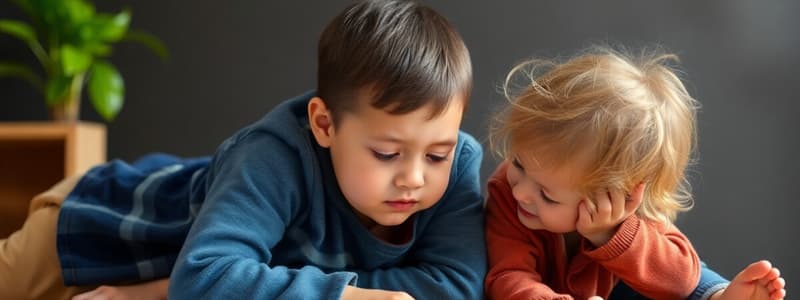Podcast
Questions and Answers
What was the primary focus of families regarding children before the 16th century?
What was the primary focus of families regarding children before the 16th century?
- Education and development
- Survival and contribution (correct)
- Cultural enrichment
- Providing emotional support
When did the idea of needing education for the common man begin to emerge?
When did the idea of needing education for the common man begin to emerge?
- Early 1700s
- Before the 16th century
- Late 1500s (correct)
- In the early 1500s
How were children treated in societies prior to modern times, according to historical perspectives?
How were children treated in societies prior to modern times, according to historical perspectives?
- Indifferently and harshly (correct)
- As equals to adults
- With great respect and affection
- With a focus on artistic development
What evidence did Philippe Ariès use to support his argument about the historical treatment of children?
What evidence did Philippe Ariès use to support his argument about the historical treatment of children?
How did the depiction of children in pre-18th century art mislead interpretations of childhood?
How did the depiction of children in pre-18th century art mislead interpretations of childhood?
What was one reason for the high infant and child mortality rates historically?
What was one reason for the high infant and child mortality rates historically?
What is one of Rousseau's major philosophies regarding education?
What is one of Rousseau's major philosophies regarding education?
According to Rousseau, what is a fundamental belief about children?
According to Rousseau, what is a fundamental belief about children?
Which educational pioneer focused on the integrated curriculum and educating the whole child?
Which educational pioneer focused on the integrated curriculum and educating the whole child?
What does Rousseau suggest about the phases of childhood development?
What does Rousseau suggest about the phases of childhood development?
What is one theme that emerges from the historical perspectives on childhood?
What is one theme that emerges from the historical perspectives on childhood?
Which educational approach emphasizes the importance of play in learning?
Which educational approach emphasizes the importance of play in learning?
What aspect of learning does Rousseau argue should be enjoyable?
What aspect of learning does Rousseau argue should be enjoyable?
What does the philosophy of child-centered education emphasize?
What does the philosophy of child-centered education emphasize?
What is the primary goal in supporting children through the resilience process?
What is the primary goal in supporting children through the resilience process?
What does the term 'WEIRD' societies refer to?
What does the term 'WEIRD' societies refer to?
Which document articulates the basic universal rights of children?
Which document articulates the basic universal rights of children?
How does childhood differ across various cultures?
How does childhood differ across various cultures?
What recognizes childhood as a separate space from adulthood?
What recognizes childhood as a separate space from adulthood?
Which organization published the 'Resilience Guide for Teachers and Parents'?
Which organization published the 'Resilience Guide for Teachers and Parents'?
What is continuous development similar to?
What is continuous development similar to?
In discontinuous development, how are the stages characterized?
In discontinuous development, how are the stages characterized?
What is the outdated belief regarding children's exposure to adversity?
What is the outdated belief regarding children's exposure to adversity?
Why is resilience considered to be developed rather than innate?
Why is resilience considered to be developed rather than innate?
What kind of praise is considered more beneficial for children?
What kind of praise is considered more beneficial for children?
How does experiencing adversity contribute to resilience in children?
How does experiencing adversity contribute to resilience in children?
What metaphor is used for discontinuous development?
What metaphor is used for discontinuous development?
What is one consequence of overly protecting children from stress and loss?
What is one consequence of overly protecting children from stress and loss?
Which model of development emphasizes gradual change without fundamental shifts?
Which model of development emphasizes gradual change without fundamental shifts?
What role do behaviors, thoughts, and actions play in resilience?
What role do behaviors, thoughts, and actions play in resilience?
Developmental Psychology studies how and why humans change throughout their lifespan.
Developmental Psychology studies how and why humans change throughout their lifespan.
Peeling a banana at two-and-a-half years old is typical behavior for a child.
Peeling a banana at two-and-a-half years old is typical behavior for a child.
The study of typical development helps to identify red flags for development that may be off track.
The study of typical development helps to identify red flags for development that may be off track.
Before the 16th century, families primarily viewed childhood as a time for education.
Before the 16th century, families primarily viewed childhood as a time for education.
High infant and child mortality rates were primarily due to malnutrition, disease, and lack of medical care.
High infant and child mortality rates were primarily due to malnutrition, disease, and lack of medical care.
Philippe Ariès argued that children were treated with great affection in historical societies.
Philippe Ariès argued that children were treated with great affection in historical societies.
The concept of treating children as miniature adults was understood to reflect a deep regard from parents.
The concept of treating children as miniature adults was understood to reflect a deep regard from parents.
Modern schools emerged as families recognized the value of educating children for a skilled workforce.
Modern schools emerged as families recognized the value of educating children for a skilled workforce.
It was widely believed that only the clergy and government officials received any education before the late 1500s.
It was widely believed that only the clergy and government officials received any education before the late 1500s.
The historical context of childhood is irrelevant in understanding child development today.
The historical context of childhood is irrelevant in understanding child development today.
Longitudinal studies are conducted over a short timeframe.
Longitudinal studies are conducted over a short timeframe.
Cross-sectional studies compare children of different ages to assess developmental changes.
Cross-sectional studies compare children of different ages to assess developmental changes.
Case studies can generalize their findings to the larger population.
Case studies can generalize their findings to the larger population.
Cross-sectional studies can be less costly than longitudinal studies.
Cross-sectional studies can be less costly than longitudinal studies.
Longitudinal studies often examine multiple aspects of development at once.
Longitudinal studies often examine multiple aspects of development at once.
Correlation and causation are interchangeable concepts in research.
Correlation and causation are interchangeable concepts in research.
Resilience is developed primarily as an innate trait.
Resilience is developed primarily as an innate trait.
The term 'WEIRD' societies refers to cultures that are Western, Educated, Industrialized, Rich, and Democratic.
The term 'WEIRD' societies refers to cultures that are Western, Educated, Industrialized, Rich, and Democratic.
The Convention on the Rights of the Child defines childhood as identical to adulthood.
The Convention on the Rights of the Child defines childhood as identical to adulthood.
Cultural perspectives on childhood can vary significantly around the world.
Cultural perspectives on childhood can vary significantly around the world.
The American Psychological Association provides resources for teachers and parents on resilience.
The American Psychological Association provides resources for teachers and parents on resilience.
The United Nations adopted the Convention on the Rights of the Child in 1989.
The United Nations adopted the Convention on the Rights of the Child in 1989.
All societies share the same views on childhood development and education.
All societies share the same views on childhood development and education.
Exposure to adversity can contribute positively to a child's resilience.
Exposure to adversity can contribute positively to a child's resilience.
The concept of childhood is consistent across all cultures.
The concept of childhood is consistent across all cultures.
Match the educational philosophers with their key ideas:
Match the educational philosophers with their key ideas:
Match the educational pioneer with their contribution:
Match the educational pioneer with their contribution:
Match the ideas about children's learning with their descriptions:
Match the ideas about children's learning with their descriptions:
Match the distinct phases of education with their proponents:
Match the distinct phases of education with their proponents:
Match the themes of development with their concepts:
Match the themes of development with their concepts:
Match the study types with their characteristics:
Match the study types with their characteristics:
Match the themes of child development with their definitions:
Match the themes of child development with their definitions:
Match the periods of education with their characteristics:
Match the periods of education with their characteristics:
Match the behaviors of children with their descriptions:
Match the behaviors of children with their descriptions:
Match the terms with their definitions:
Match the terms with their definitions:
Match the following terms with their related ideas:
Match the following terms with their related ideas:
Match the type of development with a characteristic:
Match the type of development with a characteristic:
Match the following development terms with their implications:
Match the following development terms with their implications:
Match the concepts of development with their metaphors:
Match the concepts of development with their metaphors:
Match the strategies with their descriptions:
Match the strategies with their descriptions:
Match the relationships between concepts:
Match the relationships between concepts:
Match the themes with their corresponding ideas:
Match the themes with their corresponding ideas:
Match the principles with their applications:
Match the principles with their applications:
Flashcards are hidden until you start studying
Study Notes
Definitions of Childhood
- Childhood encompasses aspects of development studied by developmental psychologists, including physical, cognitive, emotional, and social growth.
- Key differentiation exists between "growth" (physical changes) and "development" (complex acquisition of skills and abilities).
Historical Perspectives on Childhood
- The concept of childhood has evolved significantly over time; historically, childhood was viewed as a small adult's role driven by survival due to high mortality rates.
- Before the late 1500s, formal education was primarily for clergy and government officials; recognition of the need for general education emerged later.
- Philippe Ariès challenged traditional views of childhood, arguing that children were often seen as miniature adults; this perspective has been debated and nuanced over time.
- Key ideas from Ariès that persist include:
- Individualized education
- Enjoyable learning through play
- Importance of critical thinking
- Learning through sensory experiences
Influential Philosophers in Child Development
- Jean-Jacques Rousseau advocated for character development and moral growth, emphasizing exploration and natural learning experiences.
- John Locke viewed children as neutral beings whose character is developed through experiences.
- Educational contributions from various pioneers include:
- Johann Pestalozzi's integrated curriculum concept.
- Robert Owen's education expansion to infants.
- Friedrich Froebel's emphasis on play as essential for learning.
- John Dewey's focus on child-centered education and intentional teaching.
Emerging Themes in Child Development
Nature vs. Nurture
- Continuous development refers to gradual changes over time, akin to a tree's growth.
- Discontinuous development involves distinct stages, similar to a butterfly's life cycle.
Risk and Resilience
- Modern debates highlight the importance of exposing children to manageable risks to foster resilience.
- Authentic praise is preferred over indiscriminate rewards; resilience strategies can be taught and encouraged through supportive practices.
Cultural Perspectives on Childhood
- Childhood concepts are influenced by cultural contexts, with notable variations across non-WEIRD societies (Western, Educated, Industrialized, Rich, Democratic).
- The UN Convention on the Rights of the Child (1989) outlines basic rights for children, advocating for their empowerment and parental support.
- Surprisingly, the United States has not ratified the UNCRC, largely due to lobbying efforts.
Developmentally Appropriate Practice (DAP)
- Established by the National Association for the Education of Young Children (NAEYC), DAP emphasizes optimal learning and development.
- Educators consider three guiding principles:
- Knowledge of child development and learning processes.
- Recognition of every child as a unique individual.
- Awareness of each child’s social and cultural context.
Perspectives on Early Childhood
- Students will learn to identify areas for improving children's lives, historical views on child development, and the processes involved in biological, cognitive, and social-emotional development.
- Child development is delineated into distinct periods, with differing cross-cultural beliefs influencing perspectives and practices.
- Developmentally appropriate practice is essential in guiding how children are taught and understood.
Historical Perspectives
- Historically, the concept of childhood differed significantly; it was primarily focused on survival due to high infant mortality rates.
- From the late 1500s, the idea of educating the general population emerged, transitioning from elite education to broader schooling, countering earlier views of children as miniature adults.
- Philippe Ariès argued that children were treated harshly in previous centuries, but modern interpretations suggest that affection and care were present despite differing societal practices.
Cultural Perspectives
- Childhood constructs vary globally, influenced by cultural norms and societal behaviors, with differing attitudes towards childhood education and rights.
- The 1989 UNCRC established universal rights for children, acknowledging childhood as distinct from adulthood, stressing context-sensitive practices across cultures.
Methods of Studying Child Development
- Longitudinal Studies: Track the same group over time to observe development; provide detailed insights but are costly and time-consuming.
- Cross-Sectional Studies: Compare different age groups to identify developmental changes; quicker and less expensive, but risk comparing dissimilar groups.
- Case Studies: Focus on a single child or small group for in-depth understanding; reveal detailed context but lack generalizability.
Understanding Correlation vs. Causation
- Correlation indicates a relationship between variables without implying a direct cause (e.g., ice cream sales and drowning incidents).
- Causation confirms that one variable directly influences another (e.g., gravity causing objects to fall).
- Recognizing the difference is crucial in interpreting developmental research to avoid misleading conclusions.
Interesting Facts
- Moderate stress can enhance performance, indicating that appropriate levels of pressure may be beneficial for task optimization.
Definitions of Childhood
- Childhood is explored through various lenses, including historical and cultural contexts.
- Developmental psychologists study multiple areas of child growth including physical, emotional, cognitive, and social development.
- Distinction exists between growth (physical changes) and development (overall maturation) in children.
Historical Perspectives of Childhood
- Childhood perception has evolved; ancient and medieval societies focused on survival rather than education.
- High infant mortality rates influenced the value placed on children, who were seen primarily as contributors to family survival.
- The notion of educating the common child emerged post-16th century, leading to the establishment of modern schools.
Key Historical Theories
- Philippe Ariès argued that children were treated as miniature adults due to indifference, but this view has been debated.
- Major educational influences include:
- Emphasis on individualized education and enjoyable learning (Ariès).
- The belief in children learning through exploration (Rousseau).
- Integrated, holistic approaches to education (Pestalozzi).
- Focus on play as essential for learning (Froebel).
- Child-centered education prioritizing intentional teaching (Dewey).
Emerging Themes in Child Development
- Nature vs. Nurture: Ongoing debate about what influences development more strongly—genetics or environment.
- Continuous Development: Suggests a gradual, ongoing process akin to tree growth.
- Discontinuous Development: Suggests development occurs in distinct, transformative stages, similar to a butterfly's metamorphosis.
Risk and Resilience
- Modern views advocate for balanced exposure to adversity as a means of developing resilience.
- Recognizing that resilience is a learnable characteristic rather than an innate trait.
- Positive reinforcement rather than constant protective measures is crucial for healthy child development.
Research Methods in Child Development
- Longitudinal Studies: Observes a large group of children over time to study changes; provides comprehensive data but is costly and time-consuming.
- Cross-Sectional Studies: Compares different age groups at one point in time; less expensive but may not provide accurate developmental comparisons.
- Case Studies: In-depth studies of single or small groups, offering detailed insights but not generalizable to larger populations.
Understanding Correlation vs. Causation
- Correlation: Indicates a relationship between two variables without implying one causes the other; e.g., ice cream consumption and drowning rates influenced by weather.
- Causation: Establishes a direct link where one variable results from another; e.g., gravity causing objects to fall.
Additional Insights
- Limited stress can enhance performance, suggesting that some pressure may be beneficial for overcoming challenges.
Studying That Suits You
Use AI to generate personalized quizzes and flashcards to suit your learning preferences.




